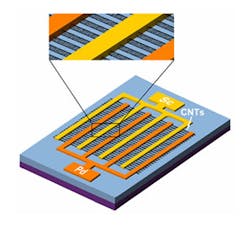Infra-red detectors made from nanotubes
A team of researchers from Peking University, the Chinese Academy of Sciences, and Duke University (Durham, NC, USA) has harnessed the properties of Single-Walled Carbon Nanotubes (SWNTs) to create a highly sensitive, un-cooled photovoltaic infra-red detector.
The team’s photovoltaic infrared detector was formed by aligning single-walled carbon nanotube arrays on a silicon substrate. The nanotubes arrays were then placed between asymmetric palladium and scandium contacts, which then formed Ohmic contacts with the valence and conduction bands of the single-walled carbon nanotube arrays.
According to Sheng Wang, an associate professor in the Department of Electronics at Peking University in Beijing, China, nanotubes react very rapidly - on the order of picoseconds - to infrared light due to their high electron mobility.
In comparison to traditional infra-red detectors, which are based on semiconductors made of a mercury-cadmium-telluride alloy, the SWNTs are an order of magnitude more efficient. What is more, the infrared light absorption characteristics of the nanotube arrays can be tuned by selecting nanotubes of different diameters.
The use of carbon nanotubes to create infra-red detectors is also underway at General Electric (Fairfield, CT, USA). Researchers there have demonstrated that by doping the butterfly scales of Morpho butterflies with single-walled carbon nanotubes, they can create new highly-sensitive thermal imaging sensors too.
More information on the Duke University device is available here.
-- by Dave Wilson, Senior Editor, Vision Systems Design
